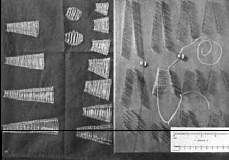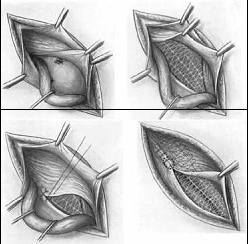Types of Hernia Mesh

In 1900, silver filigree and stainless steel were first used to help close hernia defects.
Today, nonmetals are used for hernia mesh material. The most common material used for hernia mesh today is polypropylene. We have the most experience with this mesh and it is the most widely used in the US and throughout the world. It is made in different weights, braids, and 3-dimensional configurations. It is known to cause inflammation, which is the primary modality by which it “sticks” to the tissues. The inflammation promotes tissue in-growth into the mesh, thereby forming a strong mesh-muscle(tissue) bond. In most patients, with time, the inflammation subsides. In a small proportion of patients, this inflammatory cascade can persist, causing pain and swelling in the area of the repair. This mesh has been reported to shrink in the body from 10-25% in area, depending on the way it is manufactured.
 Another common material used to make hernia mesh is polyester. This is typically a braided material. It is a soft material to touch, however, scientific reports show that once it is implanted in the body, it oxidizes and can thus be stiffer and have microscopic cracks while in the body. Most reports suggest that this mesh is less resistant to infection, possibly because it is braided and bacterial can “hide” within the folds of the braids.
Another common material used to make hernia mesh is polyester. This is typically a braided material. It is a soft material to touch, however, scientific reports show that once it is implanted in the body, it oxidizes and can thus be stiffer and have microscopic cracks while in the body. Most reports suggest that this mesh is less resistant to infection, possibly because it is braided and bacterial can “hide” within the folds of the braids.
ePTFE is the third most common material used for hernia repair. This material is quite different from the others. It is usually made in a sheet form and consider to be “macroporous.” The benefit of this mesh is that it is very neutral, with little to no inflammation associated with it. Studies show that it can shrink in the body up to 40% in area. Also, it is the least resistant to bacterial infection and is contraindicated to be placed in a contaminated or dirty areas.
Mesh technology has dramatically advanced in the past few decades. Today’s mesh options can vary in shapes, weights, and materials, including both absorbable and non-absorbable mixtures. The top companies that manufacture or distribute synthetic mesh in the US include Bard, Ethicon, Covidien, , and Gore, . Absorbable mesh materials include polyglactin materials Dexon™, or Vicryl™, mesh, which absorb within 3-8 weeks. Biologic mesh is also considered to be an absorbable mesh. It first came to general use for hernia repair and abdominal wall reconstruction in the late 1990’s. The tissue comes in sheet form and is made of cadaveric tissue, either human or animal-based. It is the most expensive alternative. At the Beverly Hills Hernia Center, Dr. Towfigh is very knowledgeable regarding all mesh options, including their risks and benefits. We always tailor the choice of mesh implantation, if any, to the needs of each individual patient.
Dr. Towfigh debates use of Biologic Mesh for hernia repair

